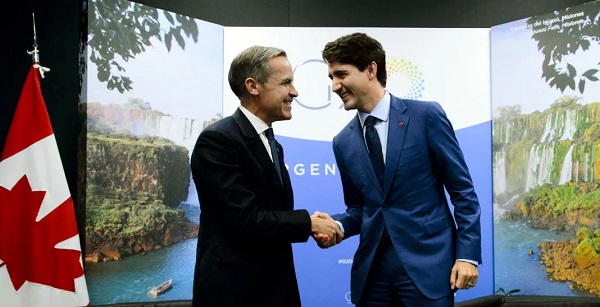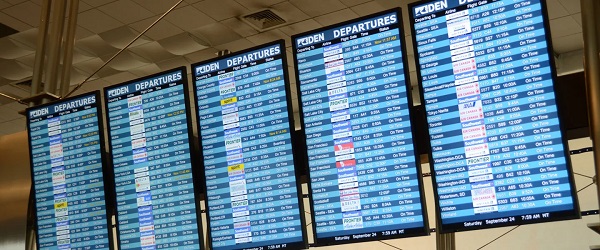International
Prime Minister Trudeau heads to NATO summit, where leaders face critical decisions

Prime Minister Justin Trudeau departs Ottawa on Sunday, June 25, 2023, en route to Iceland. Trudeau is heading to the NATO leaders’ summit in Lithuania this week, where Canada is likely to play a larger-than-usual role in two critical discussions: the alliance’s expanding membership and its efforts to refocus on collective defence. THE CANADIAN PRESS/Sean Kilpatrick
By Sarah Ritchie in Ottawa
Prime Minister Justin Trudeau is heading to the NATO leaders’ summit in Lithuania this week, where Canada is likely to play a larger-than-usual role in two critical discussions: the alliance’s expanding membership and its efforts to refocus on collective defence.
Trudeau is expected to depart for Riga, Latvia, from Ottawa on Sunday evening. He is due to meet with that country’s leaders on Monday before heading to the Lithuanian capital for the first day of the NATO summit on Tuesday.
At last year’s summit in Madrid, NATO leaders identified Russia as “the most significant and direct threat to allies’ security and to peace and stability in the Euro-Atlantic area” in a strategic concept document that set out their intent to strengthen deterrence and defence in the region.
That came after a meeting in Brussels in March 2022, when leaders agreed to deploy four new multinational battle groups on the eastern flank in Bulgaria, Hungary, Romania and Slovakia, adding to those in Estonia, Latvia, Lithuania and Poland.
The alliance has drafted a new defence plan that leaders will be asked to approve in Vilnius, one that is being described as a return to its Cold War stance.
“What we’re seeing now is really a return to NATO’s core business,” said Tim Sayle, a NATO historian and professor at the University of Toronto.
He said this likely also means a return to more challenging negotiations among members as they decide on defence policy and procurement, at the same time as they are debating whether to allow Sweden and Ukraine to join. And on both topics, he said, allies will be looking to Canada.
“Rarely are there summits where Canada would be a focus of any elements, but I do think (it) is here,” Sayle said.
“Canada has a decision to make about its role in the discussion about Ukraine, but it also has this decision to make about Canadian defence spending and just what kind of ally Canada is going to be.”
Adm. Rob Bauer, the chair of NATO’s military committee, told media at a July 3 briefing that the new defence plan is split into three parts: the southeast region including the Mediterranean and the Black Sea, the central region from the Baltics to the Alps and the High North and Atlantic region.
Once the plans are approved, the real work begins. “Then we have to go and do our work to reach the higher number of forces with a higher readiness, we need to exercise against the plans, we need to buy the capabilities that we require,” Bauer said.
That will require more money. Only about a third of NATO members are meeting the agreed-upon target of spending two per cent of their GDP on defence — which includes a pledge to dedicate one-fifth of that funding to equipment.
Bauer said he expects two per cent will be the spending floor, instead of the target, by the time the summit is over.
“There is perhaps a stronger link than ever before between the new defence plans, the new defence investment pledge and the NATO defence planning process,” NATO spokesperson Oana Lungescu said at the July 3 briefing.
For the countries that are lagging behind, there will be increasing pressure to step up.
Canada spends about 1.3 per cent of its GDP on defence and has no public plan to get to the current target. Defence Minister Anita Anand has insisted that Canada’s contributions to the defence of Ukraine and its leadership in heading up a NATO battle group in Latvia are more important.
Before attending the NATO summit, Trudeau is set to participate in meetings Monday with Latvia’s president, Edgars Rinkēvičs, and its prime minister, Krišjānis Kariņš.
Trudeau is also expected to meet Canadian Armed Forces members who are part of the country’s largest overseas mission.
But even in Latvia, Canada seems to be lagging behind. It’s been more than a year since Anand pledged to expand the battle group to a combat-ready brigade, and detailed plans are still being negotiated. Battle groups typically have close to 1,000 troops, while military members in a brigade number about 3,000.
Canada has committed to sending a tank squadron with 15 Leopard 2 tanks and some 130 personnel to Latvia starting this fall, but it is unclear how many more troops will join the 800 Canadians already in place.
Other countries have gone further. Germany has pledged to station a 4,000-soldier brigade in Lithuania. The United Kingdom, which is leading a battle group in Estonia, and the United States, which leads another in Poland, tested their ability to quickly scale up to a brigade earlier this spring.
Leaders in Vilnius are also likely to focus on the status of Sweden and Ukraine, each of which has asked to join NATO.
Last-minute talks aimed at getting Turkiye and Hungary on side with allowing Sweden to become a member have not been successful. Its Nordic neighbour Finland joined most recently, in April.
If Sweden’s membership is approved, Bauer said it won’t take long to adapt the defence plans.
“Sweden is at the table in the military committee, in the North Atlantic Council every week. So they know basically everything already,” he said.
More contentious than that is the issue of when to admit Ukraine.
Some nations are pushing for immediate membership. U.K. Defence Secretary Ben Wallace said last month that he hopes to see an expedited process.
Meanwhile, Trudeau has repeatedly stated that Canada supports Ukraine’s membership “when the conditions are right,” without defining what those conditions are.
Sayle said it’s likely that other countries will expect a clearer response this time given the magnitude of the decision: whether to admit a nation that is in the midst of an active invasion to an alliance focused on collective defence.
“I think that what NATO says about Ukrainian membership will impact both the Ukrainian and Russian strategic calculations in this war, and any peace that might follow,” Sayle said.
This report by The Canadian Press was first published July 9, 2023.
International
This ends now: Trump orders Bondi to unseal Epstein grand jury testimony

Quick Hit:
President Trump on Thursday directed Attorney General Pam Bondi to pursue the release of grand jury records in the Epstein case, saying “this SCAM…should end, right now!” Bondi said she’ll ask the court Friday to unseal the transcripts.
Key Details:
- Trump said on Truth Social he had asked AG Pam Bondi to release “any and all pertinent Grand Jury testimony” tied to Epstein, pending court approval.
- Bondi responded Thursday evening, posting, “President Trump — we are ready to move the court tomorrow to unseal the grand jury transcripts.”
- Trump’s directive comes just hours after The Wall Street Journal published a report about a birthday card he allegedly wrote to Epstein—an allegation Trump has called “fake” and vowed to sue over.
Diving Deeper:
President Donald Trump on Thursday took to Truth Social to instruct Attorney General Pam Bondi to pursue the release of sealed grand jury records. “Based on the ridiculous amount of publicity given to Jeffrey Epstein, I have asked Attorney General Pam Bondi to produce any and all pertinent Grand Jury testimony, subject to Court approval,” Trump wrote. He then added, “This SCAM, perpetuated by the Democrats, should end, right now!”
Bondi quickly responded on X, confirming her team would be in court Friday to make the request. “President Trump — we are ready to move the court tomorrow to unseal the grand jury transcripts,” she wrote.
The renewed push comes in the wake of a Wall Street Journal article published Thursday that alleged Trump sent a sexually explicit birthday card to Epstein in 2003. Trump strongly denied the claim, saying it was fabricated and promising to sue the paper for defamation.
Epstein, 66, was found dead in his Manhattan jail cell in August 2019, just a month after he was indicted by federal prosecutors in the Southern District of New York for sex trafficking minors. The official ruling was suicide, though skepticism remains widespread.
Last week, the FBI and Justice Department released the results of a long-awaited internal review. In an unsigned memo, federal officials concluded that Epstein did not have a “client list,” had not blackmailed any prominent figures, and that no further investigations into uncharged individuals were warranted. The DOJ memo said no additional disclosures would be made, effectively closing the book on the federal inquiry.
Trump, who has previously blasted the media’s obsession with Epstein, supported the memo’s findings and called the broader conspiracy a “hoax.” Still, pressure has mounted from Trump’s base and transparency advocates demanding public access to sealed documents and grand jury proceedings.
While hundreds of pages of testimony from Epstein’s 2006 Florida case were released last year, including disturbing details from victims as young as 14, the New York proceedings remain largely sealed. That Florida case ended in a controversial plea deal that saw Epstein serve just 13 months in a county jail.
With Bondi now preparing to formally request the unsealing of federal transcripts in New York, Thursday’s developments could signal a shift toward more transparency—though any release will still require approval from the court.
conflict
One of the world’s oldest Christian Communities is dying in Syria. Will the West stay silent?

This article supplied by Troy Media.
 By Susan Korah
By Susan Korah
The murder of Christians during Mass demands more than statements. Canada and its allies must act or share the blame
The June 22 suicide bombing at St. Elias Greek Orthodox Church in Damascus, which killed more than 25 people and injured over 60 during Mass, has devastated Syria’s Christian community and raised urgent concerns about their safety in a fragile, post-Assad Syria.
Activists close to the victims say the attack exposes the failure of the transitional Syrian government to protect religious minorities and underscores the need for immediate international pressure to hold the regime accountable. Without it, they warn, Syria’s ancient Christian presence could vanish.
Syria is home to one of the oldest Christian communities in the world, dating back to the first century. Though once numbering in the millions, its Christian community’s population has plummeted due to years of war, persecution and mass emigration. The attacker, linked to a shadowy extremist group called Saraya Ansari al-Sunna, opened fire on the 350-person congregation before detonating an explosive vest. The massacre has shattered the cautious optimism held by some Christians who believed Syria had turned a corner after 14 years of civil war.
“Immediately after the vicious attack, no official from the al-Sharaa government came forward to offer support except the only Christian in the cabinet, Hind Kabawat, Minister of Social Affairs,” said a Syrian Christian activist in the Toronto area who requested anonymity as he feared for his safety, even though he had emigrated to Canada years ago and serves on the refugee committee of a Melkite (Eastern rite Catholic) church.
“Our Patriarch John X issued a statement, respectfully appealing to the interim government to protect the lives and religious freedom of all Syria’s
faith groups,” he said.
Mario Bard, head of information with the pontifical charity Aid to the Church in Need Canada, said it’s imperative for the international community to take action.
“What a horrific attack,” he said. “Once again, a Christian minority community in the Middle East finds itself targeted. The local Church is already speaking of the death of its martyrs. It is a testament to the incredible faith, resilience and unshakable conviction of these communities. But that does not mean we can remain idle—far from it. ACN urges the international community not to look away and to act to ensure the protection of all religious communities in the Middle East.”
While urging governments to act, Bard reiterated that ACN will stand by its partners in Syria.
“We will continue to support the Christian community in Syria, as we have since the beginning of the war, including the Greek Orthodox Church of Antioch, with whom we have stood in the past and will continue to stand with now,” he said.
Nuri Kino of A Demand for Action, the Sweden-based humanitarian and advocacy organization he founded over 10 years ago to rally international support for Christians in Syria and Iraq targeted by ISIS for genocide, says the attack is not an isolated incident but part of a broader pattern in post-Assad Syria.
“It should be a wake-up call for the international community,” he said. “We are producing video clips and a report documenting atrocities against Christians after Assad’s fall, which will be distributed to governments that defend human rights. Our aim is to pressure the international community to ensure that financial aid given to Syria is conditional on the regime protecting the security and equal rights of Christians and all other citizens.”
As a major donor to Syria’s humanitarian recovery, Canada has leverage to tie funding to human rights protections. But so far, the Canadian government’s response has been muted, save for the usual diplomatic clichés
“Canada strongly condemns the terrorist attack at St. Elias Church in Damascus, which killed and injured civilians attending Mass on June 22, 2025. The targeting of civilians in a place of worship is deplorable,” said an email from the media relations team in response to a question posed to Foreign Affairs Minister Anita Anand. “Canada stands in solidarity with Syria’s Christian community and encourages the Syrian transitional authorities to work with partners to strengthen protections for all religious and ethnic minorities. Civilians must be protected, the dignity and human rights of all religious and ethnic groups must be upheld and perpetrators must be held accountable.”
Global Affairs has acknowledged that Syria’s security apparatus is under resourced and is not in full control of the country, as have others.
“The government’s military and security forces have not yet become organized under a central command and there is a power vacuum in that space,” said Ouhanes Shehrian, a Christian journalist based in Aleppo, Syria. “Different militias are in control of different parts of Syria, and this is a problem for the government.”
Although President Ahmed al-Sharaa’s HTS (Hayat Tahrir al-Sham) coalition led the effort to topple Assad, it now governs amid deep internal fractures. Al-Sharaa has tried to distance his party from its Islamist roots and has made some gestures toward minority groups, but observers warn that extremist factions still exert influence across various regions.
Canada, the U.S. and the EU lifted sanctions on Syria after the fall of the Assad government, a move Syriac Catholic Archbishop Jacques Mourad of Homs praised as a hopeful step for the Syrian people. Canada pledged $84 million in new funding for humanitarian assistance and temporarily eased existing sanctions to support democratization, stabilization and aid delivery during this transitional period.
Unless the international community demands real reforms and enforces conditions tied to aid, Christian leaders fear a future where minority
communities are simply left to endure or vanish.
As one local priest said after the bombing, “We prayed for peace, and we thought it had come. But now we bury our dead and wonder if we were wrong to hope.” Without swift action, what remains of Syria’s Christian presence may not survive the peace.
Susan Korah is Ottawa correspondent for The Catholic Register, a Troy Media Editorial Content Provider Partner
Troy Media empowers Canadian community news outlets by providing independent, insightful analysis and commentary. Our mission is to support local media in helping Canadians stay informed and engaged by delivering reliable content that strengthens community connections and deepens understanding across the country.
-

 Energy2 days ago
Energy2 days agoIs The Carney Government Making Canadian Energy More “Investible”?
-

 Business2 days ago
Business2 days agoCompetition Bureau is right—Canada should open up competition in the air
-

 Immigration2 days ago
Immigration2 days agoUnregulated medical procedures? Price Edward Islanders Want Answers After Finding Biomedical Waste From PRC-Linked Monasteries
-

 Business2 days ago
Business2 days agoDemocracy Watchdog Says PM Carney’s “Ethics Screen” Actually “Hides His Participation” In Conflicted Investments
-

 Business2 days ago
Business2 days agoIt’s Time To End Canada’s Protectionist Supply Management Regime
-

 COVID-192 days ago
COVID-192 days agoFreedom Convoy leaders’ sentencing hearing to begin July 23 with verdict due in August
-

 Bruce Dowbiggin17 hours ago
Bruce Dowbiggin17 hours agoHow Did PEI Become A Forward Branch Plant For Xi’s China?
-

 COVID-1916 hours ago
COVID-1916 hours agoJapan disposes $1.6 billion worth of COVID drugs nobody used






